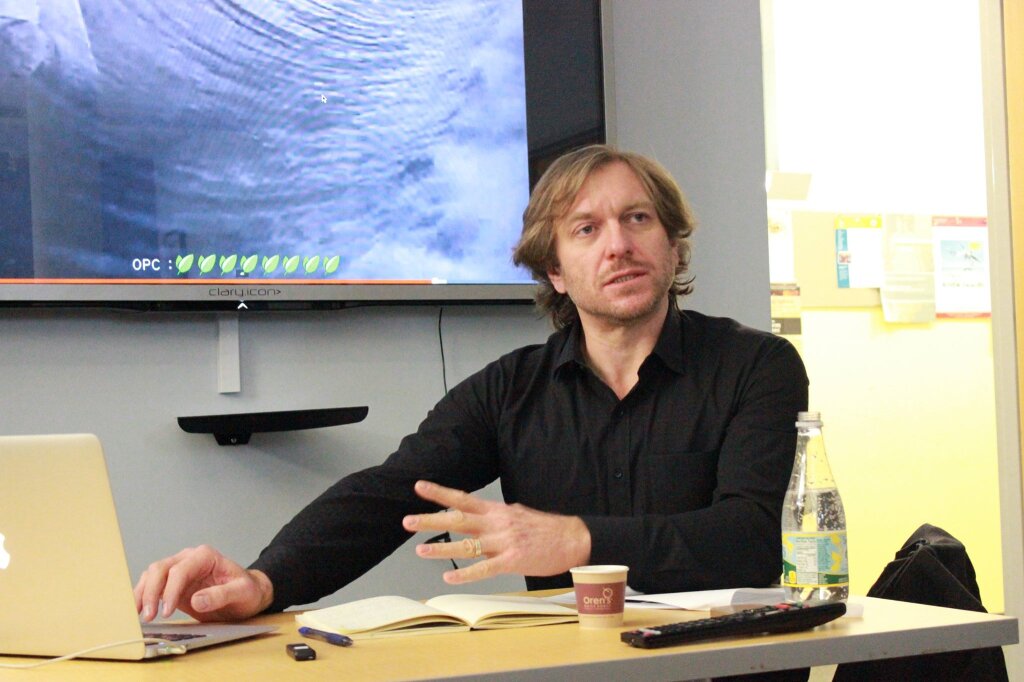On February 22, Jordan Center for Advanced Study of Russia hosted Dr. Alexey Sakhnin, who spoke about the post-Soviet emergence of a political trend consisting of both leftism and right-wing patriotism. Sakhnin received his PhD in modern Russian history and society, with a dissertation dedicated to the debates about the Soviets within the Bolshevik party, later published under the title The Experience of October: How to Make Revolution. Prosecuted as one of the public faces of the Bolotnaya protests of 2011-12, he lived for five years in exile in Sweden, before returning to Russia to work as a journalist and left-oppositional activist. He was introduced by Rossen Djagalov, Assistant Professor of Russian & Slavic Studies at New York University. Stream it here.
Sakhnin began the lecture by contextualizing the “red and brown” in the contemporary political insurgencies, especially the recent pro-Putin protests that sought to counter the supporters of Navalny. Enumerating Russia’s Communist Party and the so-called Left-Patriotic forces as the prototypical “red and brown” entities in Russia today, Sakhnin soon expanded the category to include the familiar face of the US Capitol rioter and conspiracy theorist Jacob Chansley, as well as figures like Steve Bannon, the White House's chief strategist during the first seven months of Trump's term.
“[But] red and brown was not just an intellectual stream, like Steve Bannon on Fox News. It was a huge mass movement, which you can see almost every day on the streets,” said Sakhnin.
In the Russian context, “red and brown” refers to any “anti-elite populism within the framework of the scheme, ‘the people against the government and part of the rich,’” “complete rejection and distrust of the West,” “cultural and ethical conservatism” against new music, fashion, art, sexual freedom, and sexual minority. The “brown” aspect entails patriotism and xenophobia, such as anti-Semitism and hostility towards migrants, Muslims, Caucasians. The “red” corresponds to values of equality and social justice, but ones taken away alongside a glorious past, rather than ones to be defended as rights. As a result, the “red and brown” believers sought solutions in the state and state paternalism, viewing the latter as a defender for a “temporarily occupied Motherland” -- occupied by oligarchs, Jews, and American spies. Countering democracy, the “red and brown” proponents long for immanent authoritarianism and a strong-hand leader, often reigniting a contemporary nostalgia for the Stalinist past and forging conspiracy theories against the neoliberal financial elites.
Red-brownism is not new. Sakhnin traced its precursors to the 1920s, when one of the Bolshevik leaders Karl Radek, spoke highly of a far-right German nationalist Leo Schlageter, who was executed by the French military. Radek highlighted similar tactical collaborations between communists and local nationalists in the colonial world, often in creating anti-imperialist platforms. Historically, left-right alliances were also theorized by the right-wing, as the emigre conservative Nikolai Ustryalov and the smenavekhovtsy movement he belonged to among emigre circles saw the Soviet Union as a continuation of Imperial Russia. He famously said of the USSR resembling a “radish -- red only on the outside, but white on the inside.” Sakhnin described the relationship between Stalin and Ustryalov, having lasted until the mid 1930s, as an act of “flirt” that betrayed ideologies but nevertheless survived throughout the history. Of course, it also manifested in Stalin’s famous toast to the Russian people as the first people of the Soviet Union in the 1945.
In the contemporary context, Sakhnin located the (re)birth of red-brownism in the mass discontent following the sudden retreat of the Soviet welfare state. At a time when Gorbachev’s freedom of speech could be translated de facto as the freedom to denounce communism, the Soviet public witnessed how the official media and the propaganda apparatus added “communism” to the long list of evil ideologies alongside fascism and imperialism. The popular resentment against the economic and discursive liberalization culminated in the incident of February 23, 1993, the Day of the Red Army, when the huge demonstration of war memorials was cracked down by the police in the name of democracy. The protestors associated the mass humiliations with the national feelings and the nostalgia for the bygone communist regime.
The red-brownist political economy, therefore, does not call for a return to Soviet-style planned economy -- but rather aspires to the Chinese model of transition and reform, which requires the support of industry by the state. The red directors of red-brownism demand tax incentives for factories by seeking policy support and collaboration in the parliaments -- and not by taking it to the streets. Bidding on restoring Russia to a prominent industrial power, red-brownist followers condemn the neoliberal financialization and hollowing-out of industry and, in turn, seek refuge in Stalin, China, and other symbols of industrial economy.
Lastly, Sakhnin spelled out what completes and epitomizes the history of red-brownism to be, non-surprisingly, President Vladimir Putin himself. Among the laundry list of Putin’s strategic acts of reinventing many Soviet rituals were the preservation of the Soviet hymn, the reappropriation of the Soviet flag as the symbol of victory, and most famously, the antagonism with the West and Western cultures. Sakhnin further emphasized Putin’s new social contract, where the state provides a minimal degree of social guarantees in exchange for the subsumption of the people under legality and depoliticization. For this reason, results from recent opinion polls projected Stalin to be the only candidate capable of beatingPutin.
During the Q&A, the audience were eager to find out what Sakhnin would suggest is to be done with the “brown” aspect of the ideology. Sakhnin painted a rather optimistic picture by citing new tendencies of moving towards democratic socialism among some proponents of the red and brown. However, he expressed concerns over the deficit of political participation among them, which he considered the main antidote to the brown aspect of the movement and attributed it to today’s Communist Party and the restrictions its leadership imposed on its grassroots.



